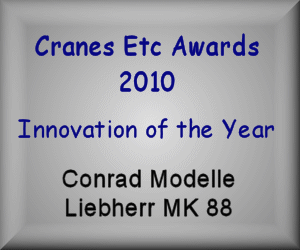 |
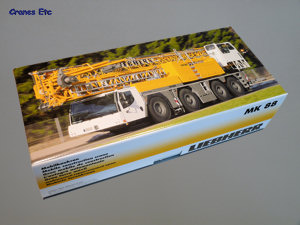 |
| Liebherr style box.
|
 |
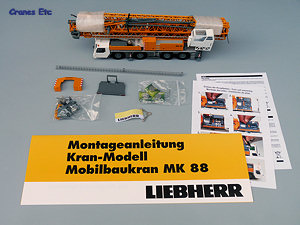 |
| The model and parts out
of the box. |
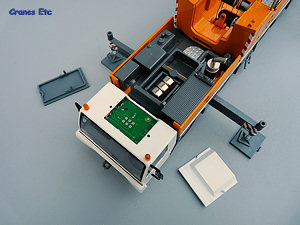 |
| The batteries for the flashing
beacons fit behind the driving cab and the switch is in the cab
roof. The additional ballast plate is shown fitted at the
back of the crane. |
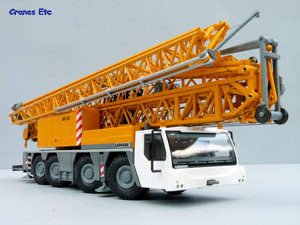 |
| The crane posed with crab
steering. |
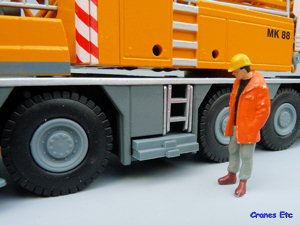 |
| Outrigger pads can be stored.
The ladder can be unfolded. |
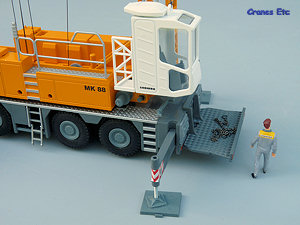 |
| The access ladder is folded
down and the cab is parked ready to be elevated to the top of the
mast. |
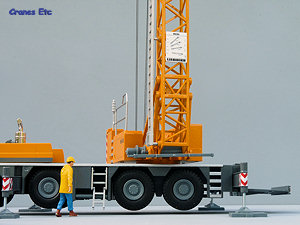 |
| The outriggers can hold
the crane off its wheels. The mast has a capacity board.
|
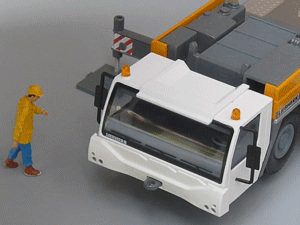 |
| The flashing beacon lights
look good. |
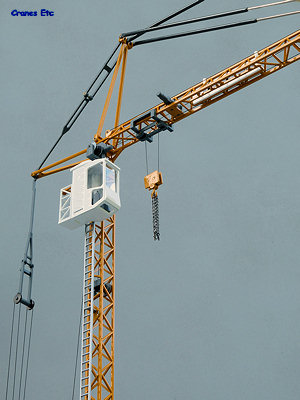 |
| Detail at the mast top
including the trolley and hook. |
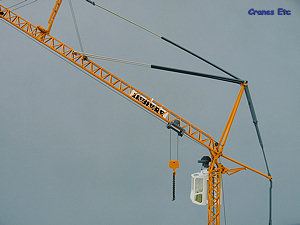 |
| It is possible to angle
the jib up to 45° as on the real machine. |
|
The Liebherr MK 88 Mobile Construction Crane
is a 4 axle machine with a maximum lifting capacity of 8 tonnes.
Depending on configuration it can lift just over 2 tonnes at the
maximum radius of 45m, and the maximum hook height is just over
30m. The jib can be angled up to 45°.
Packaging
The MK 88 comes in a higher quality Liebherr style box than normal
and inside it is packed within black foam rubber which gives it
a more professional presentation. The review model had no
defects or missing parts.
There is no information about the real crane which is a pity.
However there is a large and comprehensive instruction sheet which
is printed in German and English. It has an illustrated parts
list and is in colour. Also included is a separate pair of
leaflets describing the installation of the batteries for the flashing
beacon lights, and their operation.
There are a few small parts to fit to the model. Just like
the real crane, it is complicated so it takes a while to erect it
fully but it is straightforward if the instructions are followed.
It is robustly made but care needs to be taken not to force any
parts during erection or more particularly when folding it up.
One excellent innovation with the model packaging is the small temporary
clips Conrad has used to prevent lines from getting tangled up when
the model is unpacked and assembled. This is certainly a much
better solution than the fiddly tape often used on other models.
Detail
There is next to no detail under the model with the steering components
being purely functional for the purposes of the model. The
tyres and hubs are Conrad's usual type for crane models and this
does mean that the non-driven wheels on the first axle do not have
a correct looking hub.
The driving cab is similar to the previous MK 100 model, but it
does have a modified front bumper to represent the MK 88.
Details are simple and represent the real crane's uncluttered appearance.
Door mirrors attach to the cab and interior detail is reasonable.
The beacon lights look good, but more on this later. The outriggers
have metal beams with screw down plastic pads. Four plastic
outrigger pads are supplied and these can be stored in holders on
each side. A neat fold down ladder provides access to the
carrier deck and crane body. The carrier deck has good diamond
plate surfacing and at the rear an optional tool carrier can be
fitted.
The crane body is a good casting with panel doors and handles detailed
and the lines of the body are only broken by small access holes
for the keys to turn the winches. A metal handrail and optional
additional ballast plate are parts to be fitted. The mast
raising mechanism is in place although it is not intended to be
reeved, and it is good to see Conrad have switched to using metal
pulleys throughout on this model.
The mast is a telescopic lattice and therefore very different from
the MK 100 model. It is well made and there is a ladder section
attached to the lower part although the top section has to be fitted
when the mast is extended as obviously having the ladder telescope
was too great a modelling challenge in this scale. The ladder
also doubles as the guide rail for the elevating cab. It is
the same design as the MK 100 cab with an additional roof attachment.
The jib is metal throughout and is mechanically complex. Conrad
have done an excellent job at making the jib, the hinges, and the
pendant connections to fine tolerances so that it is geometrically
correct when erected.
The trolley is plastic, and both it and the metal hook have tiny
metal pulleys. A Liebherr flag is provided as a load to hang
from the hook.
Features
The carrier has independent steering on each axle so all modes of
steering can be reproduced and the range of movement in the steering
is good.
The outriggers can be deployed and are strong enough to support
the weight of the model when erected. The outrigger pads can
be stowed or used as desired.
The ladder to the carrier deck can be unfolded, and the tool carrier
can be added or omitted. It is advisable to fit the optional
counterweight to improve stability of the model.
It is possible to pose the crane as if undergoing the phases of
erection although this cannot be carried out by operating the winches
alone as various hand manipulations are required. When the
crane is erect it is stable, but the metal jib means that it will
not carry any significant load at radius before wanting to tip over.
Keys are supplied to operate the various winches. The cab
can be raised and lowered up and down the mast. The jib can
be unfolded and either posed horizontal or at an angle to mimic
the possibilities of the real crane. The hook can be raised
and lowered, but the trolley function is not present and it has
to be positioned by hand.
The MK 88 features an innovation in models of this scale, type and
cost. The orange beacon lights on the driving cab work.
Batteries are supplied with the crane and are fitted in a holder
within the engine compartment on the carrier, and the roof of the
cab can be removed to reveal a circuit board with an on/off switch.
In practice it works well and looks realistic, and it certainly
adds display interest when posed with working lights.
Quality
Conrad have provided a model of their typical robust quality.
Little use is made of plastic and the paintwork and graphics are
very good.
Price
The model is not cheap which reflects its complexity and features.
However it is good value.
Overall
This is a very nice model of a complex machine, and it has the added
surprise of the innovation of the working lighting. It is
interesting to see intricate model engineering now having electronics
added. Because it works well, the working lighting is a worthwhile
feature. The MK 88 is highly recommended.
Footnotes
The model first appeared at the BAUMA exhibition in April 2010.
A slightly revised version was introduced as model
2106/03.
This model was awarded Innovation of the Year for
2010 in the
Cranes Etc Review of the Year.
|
|
|
|
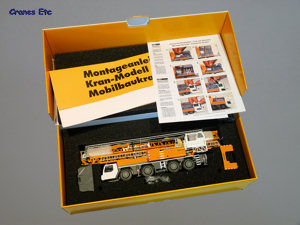 |
| High quality packing.
|
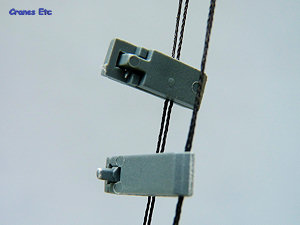 |
| A great idea. Small
plastic clips to prevent lines getting tangled. |
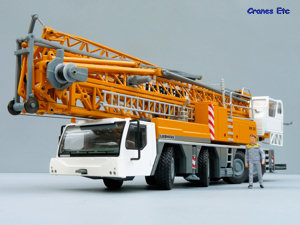 |
| Very good steering range.
|
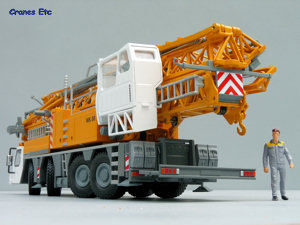 |
| The tool carrier fitted
at the back. |
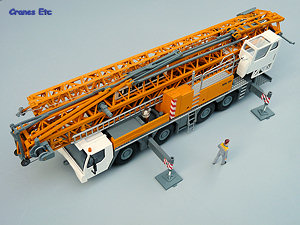 |
| Setting up with the outriggers
out. |
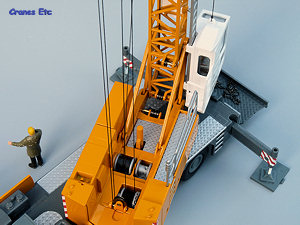 |
| Arrangement of the hoist
drums. The mast raising hoist is not reeved. |
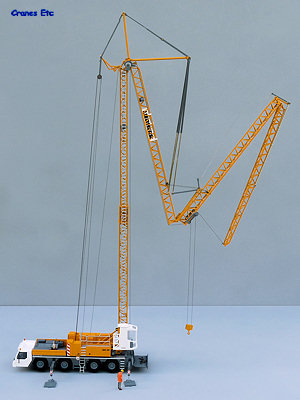 |
| The mast is raised and
the jib unfolds. |
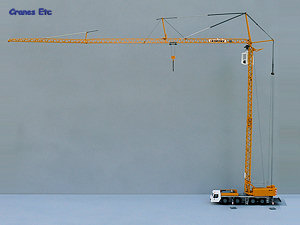 |
| The crane erected and ready
for work. |
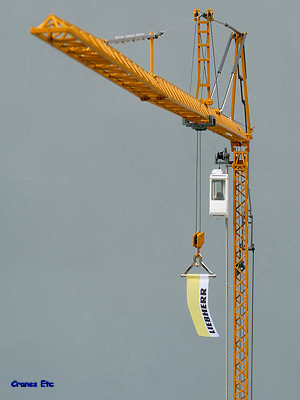 |
| Jib is very straight when
erected. |
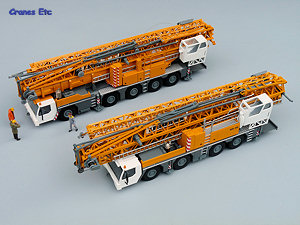 |
| Now you can have a fleet.
The MK 88 with its big brother the
MK 100. |
|

